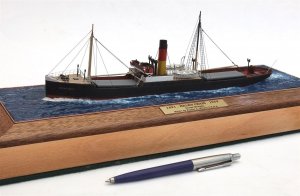Here are instructions, written by Christine. This is from the time they were made using Plasticine (Modelling clay).:
MAKING & PAINTING SEAS
By
Christine Wilson
When I first began painting the seas for the waterline models, they were handed over to me complete with their wooden edging containing the plasticine sea and a hole cut out in the centre to take the ship. At this stage, the wooden edging had been smoothed and varnished. In order to keep it clean during the painting, it was necessary to mask it off with paper masking tape. Anyone who has used masking tape will probably have realised that paint has an annoying habit of getting under the edges, especially at the corners, no matter how hard the tape has been pressed down. As a result, I usually spent two hours painting the sea and then a further hour trying to remove the excess paint from the wood without marking it. This involved twisting the finest piece of cotton wool around the end of a cocktail stick and dipping it into white spirit, with a separate one for each paint mark to avoid transferring paint to the area just cleaned. A very laborious and frustrating task!
In more recent models, the process has been greatly simplified since Robert began making a removable sea tray that is a close fit inside the wooden edging. With this system, no masking is required, and the whole sea-painting process is speeded up considerably.
Although the sea is already formed when I get it, I check that it is dust free and spend a few minutes with the sea-roller tool making a few adjustments or improvements as I see fit. Once all the lumps and irregularities are sorted out, the plasticine is primed using a matt grey aerosol priming paint such as is used in car body work repairs.
For the main sea colour I like to use Humbrol gloss enamel paint. Generally a dark hue of blue or green is favoured although I rarely use them singly. Usually two colours are used, one painted on immediately after the other and for interesting effects I sometimes blend in small amounts of metallic blues and greens. Whilst still wet, I add the bow wave, wash and wake using white enamel gloss.
Because the main colour is still wet, the white will run into it and after a while will shrink creating a streaky “foamy” sort of appearance. Because of this shrinkage I apply quite a lot of white at this beginning stage. When this is semi dry, more white can be added according to the desired “sea state”. When the whole thing is more or less completely dry I lightly stipple white paint on with a small bristle brush (held upright) to simulate spray.
The sea should enhance the model and not compete with it and therefore I have found it best to avoid bright shades of blue or green that tend to make the scene look garish. As most of the models have black or other dark hulls a fairly colourful sea is still required. Grey always seems appropriate when a “rough” sea is called for but this would look very depressing against anything other than a brightly coloured ship.
After the sea has dried thoroughly, the removable tray containing it may be glued inside the wooden edged base and a tightly twisted length of 24swg wire glued around the junction between sea and edging. This makes for a very neat finish to the sea.
Once the model has been completed and fitted into the sea, the final touches may be added. This consists of pushing the plasticine as close to the hull as possible. This still leaves a dry looking junction that needs to be dealt with. I use a thick, clear liquid acrylic to fill the gap. Whilst it is still liquid, it is of a cloudy appearance, but it dries clear. It may also be mixed with acrylic paint, as the wake of water alongside the hull is usually white rather than clear. The use of acrylic makes for a very effective “wet” looking junction between hull and water.
After a few days, a further inspection of the sea may reveal some small area which needs touching up or improving in some small way.




